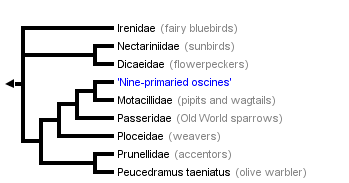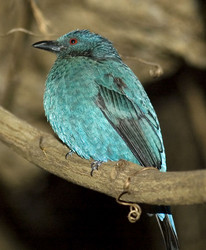Passeroidea
David P. Mindell, Joseph W. Brown, and John Harshman


This tree diagram shows the relationships between several groups of organisms.
The root of the current tree connects the organisms featured in this tree to their containing group and the rest of the Tree of Life. The basal branching point in the tree represents the ancestor of the other groups in the tree. This ancestor diversified over time into several descendent subgroups, which are represented as internal nodes and terminal taxa to the right.

You can click on the root to travel down the Tree of Life all the way to the root of all Life, and you can click on the names of descendent subgroups to travel up the Tree of Life all the way to individual species.
For more information on ToL tree formatting, please see Interpreting the Tree or Classification. To learn more about phylogenetic trees, please visit our Phylogenetic Biology pages.
close boxDiscussion of Phylogenetic Relationships
There is some question whether Passeroidea includes Promeropidae (shown directly under Passerida), but the rest of the superfamily is clearly monophyletic (Barker et al. 2002, 2004; Ericson and Johansson 2003; Beresford et al. 2005). Nectariniidae (sunbirds) and Dicaeidae (flowerpeckers) are sisters (Barker et al. 2002, 2004; Ericson and Johansson 2003; Beresford et al. 2005), and form a trichotomy with Irenidae (fairy bluebirds) and remaining passeroids (Barker et al. 2002, 2004; Beresford et al. 2005). Peucedramus (olive warbler), previously thought to be either a parulid or basal within 9-primaried oscines (Sibley and Monroe 1990) is instead sister to Prunellidae (accentors) (Ericson and Johansson 2003), and these are sister to the remaining passeroids (Barker et al. 2002, 2004; Ericson and Johansson 2003; Beresford et al. 2005). Passeridae (Old World sparrows) and Motacillidae (pipits and wagtails) are successive sister groups to the nine-primaried oscines (Barker et al. 2002, 2004; Ericson and Johansson 2003). Though this is weakly supported in each analysis, agreement between analyses and a three-codon insertion in the c-myc sequences (Ericson et al. 2000) are conclusive.
References
Barker, F. K., G. F. Barrowclough, and J. G. Groth. 2002. A phylogenetic hypothesis for passerine birds; Taxonomic and biogeographic implications of an analysis of nuclear DNA sequence data. Proc. R. Soc. Lond. B 269:295-308.
Barker, F. K., A. Cibois, P. Schikler, J. Feinstein, and J. Cracraft. 2004. Phylogeny and diversification of the largest avian radiation. Proc. Natl. Acad. Sci. USA 101:11040-11045.
Beresford, P., F. K. Barker, P. G. Ryan, and T. M. Crowe. 2005. African endemics span the tree of songbirds (Passeri): Molecular systematics of several evolutionary "enigmas". Proc. R. Soc. Lond. B 272:849-858.
Ericson, P. G. P., U. S. Johansson, and T. J. Parsons. 2000. Major divisions in oscines revealed by insertions in the nuclear gene c-myc: A novel gene in avian phylogenetics. Auk 117:1069-1078.
Ericson, P. G. P., and U. S. Johansson. 2003. Phylogeny of Passerida (Aves: Passeriformes) based on nuclear and mitochondrial sequence data. Mol. Phylogen. Evol. 29:126-138.
Harshman, J. 2007. Classification and phylogeny of birds. Pages 1-35 in Reproductive biology and phylogeny of birds (B. G. M. Jamieson, ed.). Science Publishers, Inc., Enfield, NH.
Title Illustrations

| Scientific Name | Loxia curvirostra |
|---|---|
| Location | Deschutes National Forest, Oregon, USA |
| Comments | Red Crossbill |
| Creator | Dave Menke |
| Specimen Condition | Live Specimen |
| Source Collection | U.S. Fish and Wildlife Service Online Digital Media Library |
| Scientific Name | Motacilla cinerea |
|---|---|
| Location | Russia, Republic of Altai, Iogach river |
| Specimen Condition | Live Specimen |
| Sex | Male |
| Source | Grey Wagtail |
| Source Collection | Flickr |
| Image Use |
 This media file is licensed under the Creative Commons Attribution-NonCommercial-NoDerivs License - Version 2.0. This media file is licensed under the Creative Commons Attribution-NonCommercial-NoDerivs License - Version 2.0.
|
| Copyright | © 2006 Sergey Yeliseev |
| Scientific Name | Irena puella |
|---|---|
| Location | captive at Philadelphia Zoo |
| Specimen Condition | Live Specimen |
| Sex | Female |
| Source | Feeling Blue |
| Source Collection | Flickr |
| Image Use |
 This media file is licensed under the Creative Commons Attribution-NonCommercial-NoDerivs License - Version 2.0. This media file is licensed under the Creative Commons Attribution-NonCommercial-NoDerivs License - Version 2.0.
|
| Copyright | © 2006 Marty DeAngelo |
About This Page
David P. Mindell

California Academy of Sciences, San Francisco, California, USA
Joseph W. Brown

University of Michigan Museum of Zoology, Ann Arbor, Michigan, USA
Correspondence regarding this page should be directed to David P. Mindell at , Joseph W. Brown at , and John Harshman at
Page copyright © 2006 David P. Mindell, Joseph W. Brown, and
 Page: Tree of Life
Passeroidea.
Authored by
David P. Mindell, Joseph W. Brown, and John Harshman.
The TEXT of this page is licensed under the
Creative Commons Attribution-NonCommercial License - Version 3.0. Note that images and other media
featured on this page are each governed by their own license, and they may or may not be available
for reuse. Click on an image or a media link to access the media data window, which provides the
relevant licensing information. For the general terms and conditions of ToL material reuse and
redistribution, please see the Tree of Life Copyright
Policies.
Page: Tree of Life
Passeroidea.
Authored by
David P. Mindell, Joseph W. Brown, and John Harshman.
The TEXT of this page is licensed under the
Creative Commons Attribution-NonCommercial License - Version 3.0. Note that images and other media
featured on this page are each governed by their own license, and they may or may not be available
for reuse. Click on an image or a media link to access the media data window, which provides the
relevant licensing information. For the general terms and conditions of ToL material reuse and
redistribution, please see the Tree of Life Copyright
Policies.
- First online 22 June 2006
- Content changed 02 August 2006
Citing this page:
Mindell, David P., Joseph W. Brown, and John Harshman. 2006. Passeroidea. Version 02 August 2006 (under construction). http://tolweb.org/Passeroidea/67278/2006.08.02 in The Tree of Life Web Project, http://tolweb.org/











 Go to quick links
Go to quick search
Go to navigation for this section of the ToL site
Go to detailed links for the ToL site
Go to quick links
Go to quick search
Go to navigation for this section of the ToL site
Go to detailed links for the ToL site